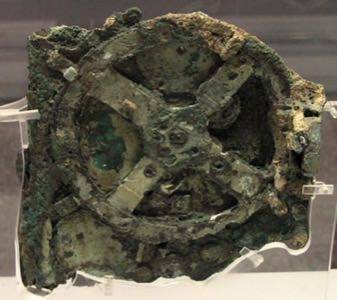The Antikythera Mechanism, built in the 2nd century B.C. and recovered in 1900, is the most complex machine to survive from ancient times. Looking like a sophisticated time piece, it turned out to be just that. The device apparently calculated the positions of the moon, sun and known planets. But recent work has revealed an additional element of sophistication: it tracks the sun’s relative speeds at different times of the year.

The Hellenic device, thought by many to have been used as a calculator for religious festivals. is widely considered to be the oldest extant analog computer. It has between 30 and 70 gears and a host of other parts. The two concentric rings on the face contain the Greek zodiac and the Egyptian months.
To describe the relative speed of the sun (based on the elipitical route of the Earth around it), the mechanism’s makers have increased the distance of the zodiac sections on the device to reflect the apparent difference in the sun’s pace across the sky.

Wired quotes University of Puget Sound physics professor James Evans, who led the investigations of the latest team, on why the makers did not gear the difference, as they did the change of the moon’s speed. The difference in the speed of the sun is much more slight than the moon. Gearing such a difference, said Evans, would be exceedingly complex.
“Evans and colleagues suggested a simpler way to make the sun dial appear to change speed: Stretch the zodiac. If the spaces on the front wheel of the mechanism were of different widths, Evans reasoned, then the hand representing the sun would take longer to travel through the part of the year lumped under the zodiac sign of Taurus than through Libra.”
The original find was a corroded lump. Since then, the device has been scanned using a number of technologies, the most recent a 3D x-ray scan. The scans have shown the constituent parts, most of which would have remained unknown otherwise.
This additional element of the Antikythera mechanism does not make the favorite theory of its use any more or less likely to be true. Nor does it answer the questions of where such complex engineering came from and where it went. It does hint that the mechanism may hold additional secrets and that is exciting for its own sake, quite apart from what it might teach us about our past.
Difference engine photo by Liz Henry | Antikythera image from Wikipedia | other sources: A Blog About History










